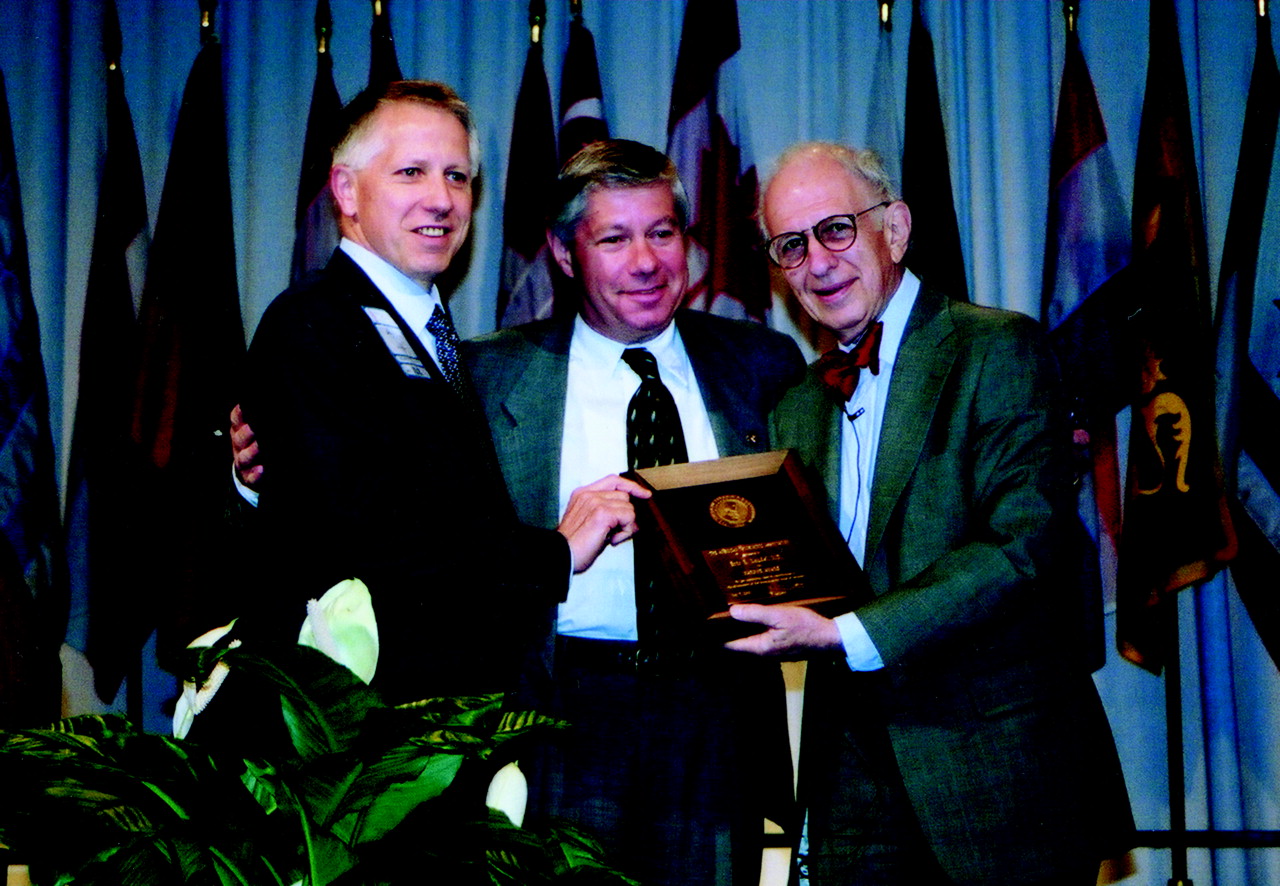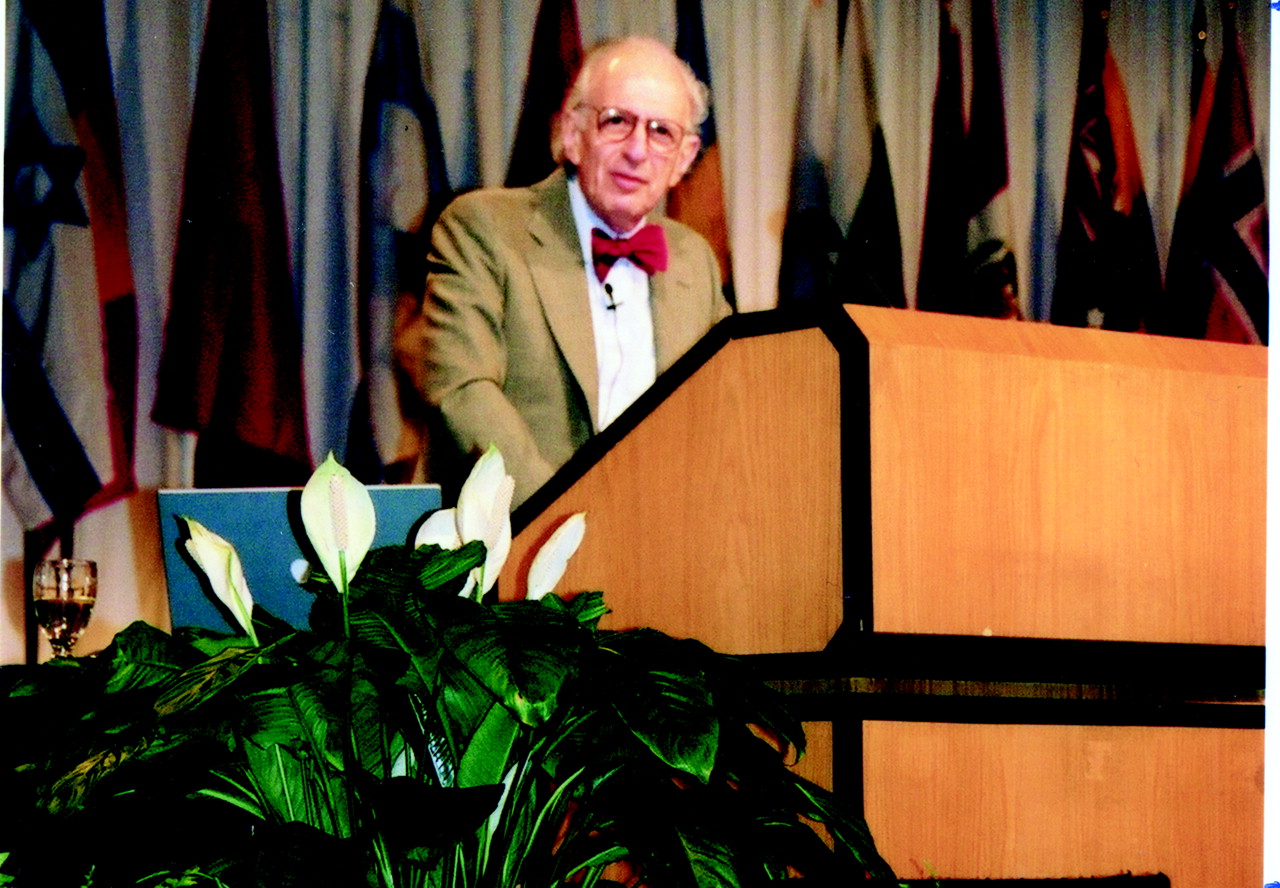Noting that “we are what we are through what we have experienced and what we have remembered,” this year’s APA Marmor Award lecturer, Eric R. Kandel, M.D., detailed fundamental cellular processes underlying the biological connection between the mind and the brain. But what the audience of nearly 2,000 annual meeting attendees took away from the lecture was Kandel’s promise that his lecture would change their minds, literally as well as figuratively.
“When I came up with the annual meeting theme of ‘Mind Meets Brain,’ ” said APA President Daniel Borenstein, M.D., in introducing Kandel, “the first person I thought of to invite to speak at this meeting was Dr. Kandel. I was delighted to have him accept. I think he truly epitomizes where we are in our science at this point.”
APA Medical Director Steven Mirin, M.D., presenting the 2001 Marmor Award to Kandel, said, “Dr. Kandel’s work has been essential, not only for our basic understanding of the mechanisms of learning and memory, but also for highlighting many of the cellular processes that are affected by psychiatric medications.”
The Marmor Award lectureship is awarded annually to a researcher who significantly advances the biopsychosocial model of psychiatry. The award was endowed by former APA President Judd Marmor, M.D.
“I am keenly aware of the fact,” Kandel said, “that awards such as [the Nobel Prize] recognize not only Arvid Carlson, Paul Greengard [with whom he shared the 2000 Nobel Prize in Medicine], and myself, but recognize research into the biology of mental problems on the whole. It really recognizes the prominence of psychiatry that is emerging throughout the world.”
The molecular basis of learning and memory fascinated him so much, Kandel told the standing-room-only audience, because it addresses one of the most remarkable aspects of human behavior, the ability to acquire new ideas and patterns of thought from experience. “Many psychological and emotional processes are thought to be built on experience and specifically on learning,” Kandel said.
Kandel described his 40 years of research into the cellular processes underlying learning and memory, first in the sea slug Aplysia, then later in mice. Displaying for the audience a comically altered photograph of one of his “pet” snails, Kandel commented, “Aplysia is a very beautiful animal, just the sort of animal that anyone would pick for research into learning and memory.”
He and his colleagues chose the snail because of the remarkably low number of relatively large neurons in its nervous system. Yet with only 20,000 neurons total, some large enough to see with the naked eye, the animal is capable of displaying modifications in its behavior due to environmental stimuli—otherwise referred to as the ability to learn.
“ What learning does is to change the strength of the synaptic connections in the brain,” Kandel explained, “and this has held true for every form of learning so far analyzed. So, what genetic and developmental processes do is specify the cells that connect to each other, but what they do not specify is the exact strength of those connections. Environmental contingencies, such as learning, play a significant part in the strength of those connections.”
Different forms of learning result in memories by changing that strength in different ways. Short-term memory results from transient changes that last minutes and does not require any new synthesis of proteins, Kandel said. However, long-term memories are based in more lasting changes of days to weeks that do require new brain protein to be synthesized. And this synthesis requires the input of the neuron’s genes.
The Biology of Psychiatry
“A learning event—a social experience, a psychotherapeutic event—is capable of activating genes in the brain of experimental animals and people,” Kandel explained, and this new gene expression leads to a change in behavior as a result of learning and memory.
“If you were to remember anything at all about this lecture,” Kandel emphasized, “it is because you walk out of this lecture with a somewhat different head than when you walked in—and all without taking any drugs!
“And I tell you that insofar as psychotherapy produces enduring changes in peoples’ behavior, it does so by producing enduring changes in peoples’ brains; and those enduring changes are carried by changes in the structure of the brain.”
Kandel said that the study of memory storage has not only provided insight into the process of memory storage itself, but also revealed completely unanticipated features of the cell biology of neurons, which would not have happened unless researchers such as himself had approached the brain with specific psychological questions in mind.
“And I am confident,” he concluded, “that as the biology of the mind takes over the central stage of medicine as a whole, the contributions that will come will have enormous impact on the practice of medicine. There is every reason to believe that the biology of the mind will capture the excitement of the scientific community in the next 50 years the way the biology of the gene has captured the imaginations of the scientists of the last 50 years.”
It is inevitable, Kandel declared, that the contributions that come from the study of the biology of the mind will be recognized as among the most significant contributions of all time.
Kandel acknowledged that he finds it awkward to think of himself as the only American psychiatrist ever to have been awarded the Nobel Prize. “One would hope that in the future, as young people move into psychiatric research, their contributions will so enrich our field that many, many more recognitions will come.” ▪


